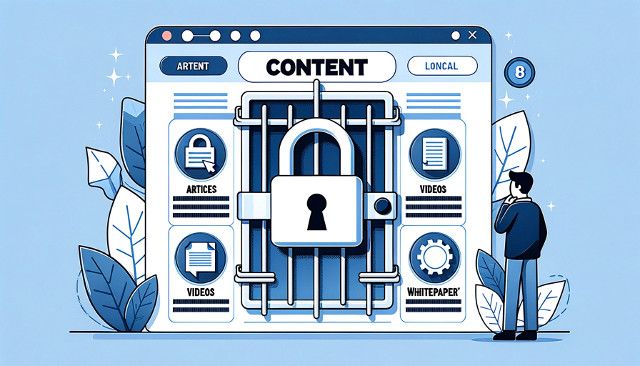
Gated Content: A Comprehensive Guide for Small Businesses
In the evolving landscape of online marketing, it's essential for small businesses to stay ahead of the curve. One strategy that has gained traction is the use of "gated content". But what is it?
And how can it benefit your business? At MBCS, we're dedicated to helping you navigate the digital world, and this guide will provide you with insights into the world of gated content.
“In the rapidly changing digital landscape, businesses need to be flexible and adaptive. Gated content is just one tool in the arsenal, but when wielded correctly, it can be transformative for your online presence.”
What is Gated Content?
At its core, gated content is any online material (e.g., articles, videos, whitepapers) that requires users to fill out a form or take some action before accessing it. Typically, this means providing personal information such as an email address, which can then be used for future marketing efforts.
Why is Gated Content Important?
- Lead Generation: By requiring users to provide their details, you can build a robust database of potential customers, helping you target your marketing more effectively.
- Value Perception: Gated content can be perceived as more valuable since it's seen as exclusive or premium, elevating your brand's reputation.
- Segmentation: Through the data collected, you can understand what specific content attracts which audience, allowing for better-targeted marketing campaigns.
Different Approaches to Gated Content:
- Fully Gated: Content is entirely behind a form. Users must provide their information to access any part of it.
- Pros: Higher value perception; clear data on who's interested.
- Cons: Might deter users who don't want to share info.
- Partially Gated: Only some sections of the content are behind a gate, giving a teaser to the audience.
- Pros: Provides a balance between freely accessible and exclusive content; can intrigue users to give their details.
- Cons: Less exclusivity can lead to a lower value perception.
- Time-based Gating: Content is free initially but gets gated after a specific period.
- Pros: Can draw in a wide audience initially, then capitalize on the content's popularity.
- Cons: Can be confusing or frustrating for users who come back to find content they previously accessed is now gated.
How Do You Create Value With Gated Content?
Creating value with gated content involves striking the right balance between what you're asking from your audience and what you're offering in return. It's a strategy that, when done correctly, can boost lead generation, customer engagement, and brand authority.
“Gated content is not just about capturing leads; it's about starting a relationship with potential customers. If the first interaction doesn't deliver genuine value, it can harm the brand's reputation. Always prioritize the audience's needs and expectations when creating and gating content.”
Here's how to create genuine value using gated content:
- High-Quality Content: This is paramount. Ensure that the content behind the gate is of top-tier quality, relevant, and offers solutions or insights that aren't easily found elsewhere. Your audience must feel that the exchange (their information for your content) was worth it.
- Solve a Problem: Your gated content should address specific pain points or challenges that your target audience faces. Whether it's a guide, a whitepaper, a webinar, or a toolkit, it should provide actionable solutions.
- Exclusive Access: Position your gated content as exclusive or limited-edition. This not only creates a sense of urgency but also makes your audience feel they're getting something special that's not available to everyone.
- Use Attractive Lead Magnets: Lead magnets like eBooks, templates, or webinars can be strong incentives for users to provide their information. They're tangible, actionable, and often perceived as high-value.
- Optimized Landing Pages: The page where you gate your content should be clear, concise, and compelling. Use persuasive copy, impactful visuals, and clear call-to-actions (CTAs) to encourage sign-ups.
- Segment and Personalize: Use the information you gather to segment your audience and deliver personalized content in the future. This not only increases engagement but also shows your audience that you value and understand their individual needs.
- Test and Optimize: Continuously monitor how your gated content is performing. Are users engaging with it? Are they turning into leads or customers? Use this data to refine your strategy, tweaking what doesn't work and amplifying what does.
- Maintain Transparency: Be upfront about what users are signing up for. If they're going to receive newsletters or promotional content in the future, let them know. This builds trust and reduces the chances of users feeling deceived.
- Offer a Preview: Giving a sneak peek or a teaser of the gated content can pique interest. If users can see the quality and relevance of what they'll get, they're more likely to sign up.
- Consistent Value Delivery: After the initial sign-up, continue to provide value to your audience, be it in the form of newsletters, updates, or more exclusive content. This nurtures the relationship and can lead to long-term brand loyalty.
Types of Gated Content:
As you have learned in this article, gated content requires users to take a specific action (usually providing personal details) before they can access it. But what kinds of content can be gated? The options are vast and varied, catering to different business needs and audience preferences. Let's delve deeper into the types of gated content most commonly utilized by small businesses:
- Whitepapers and E-books:
- Description: These are comprehensive, detailed documents that provide in-depth insights on a particular topic, trend, or issue. They're often used to establish a company's authority in a particular domain.
- Best for: B2B businesses, tech companies, and any business looking to highlight in-depth research or expertise on a subject.
- Webinars and Online Courses:
- Description: Interactive online sessions or courses, which can be live or pre-recorded, offering education or training on a particular topic.
- Best for: Educational institutions, expert individuals, software companies offering tutorials, or any business offering training in a specific area.
- Case Studies:
- Description: Detailed analysis of specific projects or endeavors undertaken by a company, highlighting challenges, solutions, and results.
- Best for: Businesses offering solutions (products or services) and want to showcase real-world applications and successes.
- Templates and Tools:
- Description: Downloadable resources such as checklists, spreadsheets, or design templates that provide practical utility to the user.
- Best for: Businesses in the creative sector, marketing agencies, consulting firms, or any company offering tools related to their products or services.
- Exclusive Articles and Reports:
- Description: Written content that provides exclusive insights, analyses, or information not readily available elsewhere.
- Best for: Media companies, research firms, or any business that produces original research or insights.
- Premium Video Content:
- Description: High-quality, exclusive video content such as tutorials, behind-the-scenes footage, interviews, or mini-courses.
- Best for: Entertainment companies, influencers, educators, or brands using video as a primary content medium.
- Discounts and Special Offers:
- Description: Exclusive deals or offers available only to those who provide their details.
- Best for: E-commerce businesses, retailers, or any business looking to boost sales through special promotions.
- Newsletters and Magazines:
- Description: Periodic content sent to subscribers, often encompassing industry news, company updates, and other relevant information.
- Best for: Almost any business, especially those aiming to maintain regular engagement with their audience.
The types of gated content you choose to implement should align with both your business objectives and the preferences of your target audience. By offering valuable content that resonates with your users and meets their needs, you can effectively leverage the power of gated content to build a strong, engaged community around your brand.
How to Implement Gated Content:
- Choose the Right Content: Not everything should be gated. Choose content that you believe holds significant value for your audience.
- Design an Attractive Landing Page: This is where users will fill in their details. Ensure it's user-friendly, mobile-optimized, and aligns with your brand.
- Promote: Use your other marketing channels, like social media or email campaigns, to drive traffic to your gated content.
- Analyze & Adapt: Monitor how your gated content performs. Are users filling out the form? If not, you might need to adjust your strategy.
A Strategy for Small Businesses:
- Start Small: If you're new to gated content, begin with partially gating a piece of high-value content. This way, you can gauge your audience's reaction without a significant commitment.
- Promote Wisely: As a small business, your resources might be limited. Focus your promotional efforts on platforms where your target audience hangs out.
- Engage After the Gate: Once a user provides their information, engage them with follow-up emails or offers. This keeps the momentum going and can lead to conversions.
Conclusion:
Gated content, when used strategically, can be a powerful tool for small businesses. It not only helps in generating leads but also in positioning your brand as an authority in your field. At MBCS, we believe in empowering businesses with the right strategies and tools. Gated content might be the strategy you need to give your digital marketing efforts an edge. However, like all strategies, it's essential to monitor, analyze, and adjust based on your unique business needs and audience responses.
Remember, the key is to always ensure the value of the gated content justifies the "price" of the information you're asking your audience to provide. When done right, gated content can be a win-win, offering value to your audience while providing you with invaluable insights and leads.
Optimize Your Online Marketing with MBCS
Embark on Your Digital Marketing Journey with MBCS. The trajectory from mere online visibility to significant brand recognition is sophisticated and requires astute expertise. With the fast-paced advancements in online marketing trends, crafting a formidable online brand presence is essential. At MBCS, we are devoted to guiding you through this intricate expedition.
We specialize in curating robust marketing campaigns that not only resonate with your target audience but also spur them to positive action. More than just impressions, we emphasize generating meaningful engagements, high-quality leads, and fostering long-term customer relationships.
Are you set to boost your brand's online footprint and master the nuances of effective digital marketing? Begin your ascent with MBCS. Contact us for an obligation-free discussion, and let’s explore the vast opportunities that online marketing presents. You can also visit our website at www.microbizops.com.


